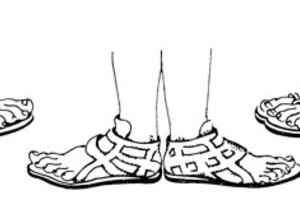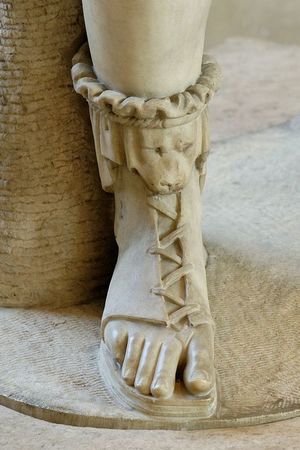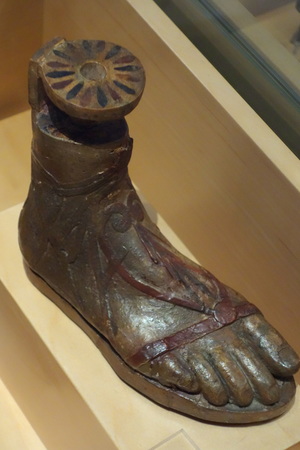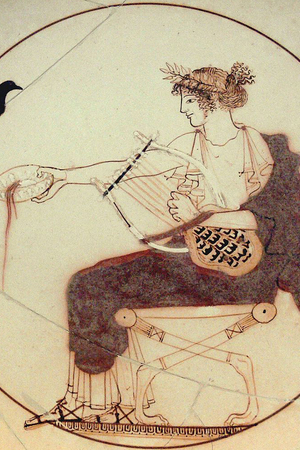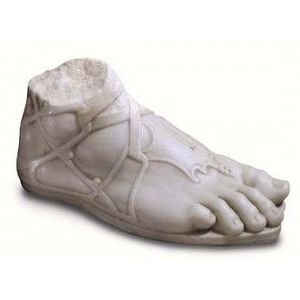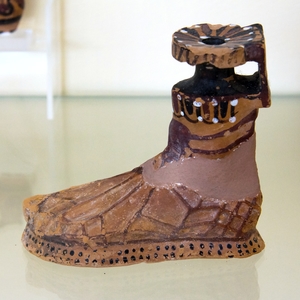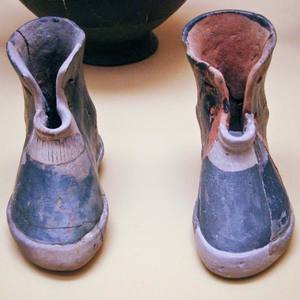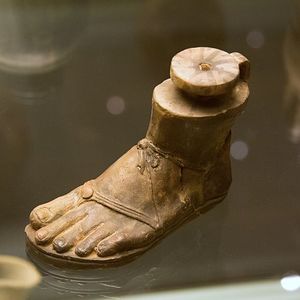Greek Footwear
Today, we have a wealth of information about the footwear of ancient Greeks, which allows us to refer to written and pictorial sources. Footwear is depicted on ancient Greek pottery and numerous statues, enabling us to appreciate the technical knowledge and skills of ancient craftsmen required for shoemaking. It is believed that leather was the main material used for making footwear, although leather samples of Greek footwear have not been found by archaeologists, unlike Roman footwear.
Greek footwear underwent significant changes over time and should be examined in relation to different periods. During the Archaic period, footwear varied in terms of form and construction. In the 6th century BC, colonizers brought soft fabric shoes with curved tips from Asia Minor, known as poulaines. In the same period, closed shoes made of soft leather, fastened with a strap around the ankle in the Persian fashion, appeared. They were called persikai. The footwear of ancient Etruscans is analogous to this type of footwear.
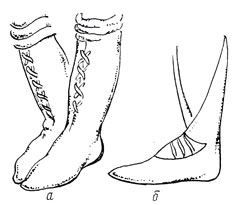 Persicai (a), Etruscan shoes (b)
Persicai (a), Etruscan shoes (b)
The most common footwear among ancient Greeks was sandals. Many Roman variations of this type of footwear have been found, suggesting that Greeks likely had similar examples in common use. Greek sandals did not impede natural foot movement, had elastic soles, and were specifically designed for the right and left foot. The comfort of sandals was achieved through the specific arrangement of straps, one of which necessarily passed between the big toe and the second toe and pressed against the foot, extending to the inner part of the sole. The side straps crossed each other, reinforcing the ankle joint. Starting from the 5th century BC, loops were added to the sandals, reaching up to nine in number. The main strap passed through these loops, encircling the calf.
Some types of leather sandals were expensive, so people with limited means wore either simpler models or sandals with wooden soles. The soles of wealthy individuals' sandals were made of multiple layers of cowhide, and the upper straps were dyed in different colors, likely cut from goat leather. From ancient literary works, it is known that affluent citizens of Athens, Alcibiades and Ificrates, were influential trendsetters in sandal fashion.
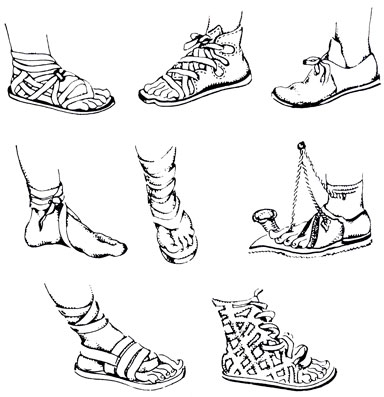 Varieties of Ancient Greek sandals
Varieties of Ancient Greek sandals
Footwear of the classical period is distinguished by high craftsmanship. Instead of loops in the leather, they began making perforations of different diameters and shapes through which leather straps were threaded. Sandals with soles that corresponded to the contour of the toes emerged. Footwear with such soles was later called lingula by the Romans. Until the 5th century BC, Greeks often wore knee-high footwear known as embades.
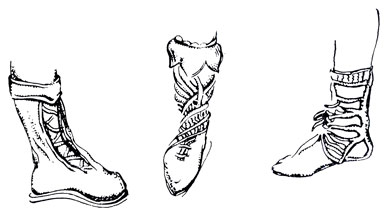 Ancient Greek ambads
Ancient Greek ambads
During the Hellenistic period, Greeks mainly wore tall leather footwear called endromis for horseback riding and during military campaigns. Sculptures that have survived depict mythological heroes such as Dionysus, Hercules, and Perseus wearing this type of footwear.
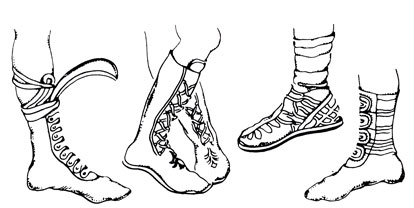 Ancient Greek endromis
Ancient Greek endromis
In the second half of the 5th century BC, Greece saw the emergence of laced footwear with an open toe, reaching mid-calf and laced with leather cords. These were called koturna and were worn by Greeks only on stage. Later, high-heeled koturna appeared. At the end of the 5th century BC, soft shoes with an upturned toe, originating from Asia Minor, became fashionable in Greece. The most common footwear for ordinary Greek young men was carbatinae and boots.
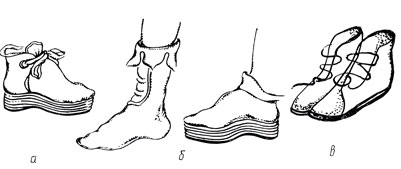 Ancient Greek cotournes (a), carbatines (b), light boots (c)
Ancient Greek cotournes (a), carbatines (b), light boots (c)
During the Hellenistic period, sandals were adorned with various metal fittings. Men's sandals with a leather back and open toes were called krepides. They somewhat resembled Assyrian sandals. Wealthy individuals would place a piece of leather, a kind of tongue, under the straps of krepides. Footwear for special occasions was made of colored leather and decorated with ornamentation, embroidery, inlay, and pearls. Footwear with thick soles was highly valued.
The most common colors of footwear were black, followed by red, yellow, and white. They were cleaned using a sponge. It is known that footwear with felt soles or cork soles was exclusively worn by hetairai (courtesans). Shoes were taken off during meals.
The approximate price of footwear in ancient times can be deduced from Aristophanes' phrase: "Eight drachmas for a pair of sandals is a lot of money!"
During excavations at the Athenian Agora, a 5th-century BC dwelling was discovered, containing numerous nails with broad heads and bone inserts for strap lacing. A kylix found near the dwelling with the inscription "Σίμωνος" (Simon) suggests that the dwelling belonged to Simon's workshop, which, according to Xenophon, was visited by Socrates. When Socrates conversed with someone, Simon would record those dialogues from memory.
On a 6th-century BC amphora, one can see a buyer stepping on a piece of leather on a table in a workshop, where his foot would be traced and the sole cut to size. On the same kylix from that era, a master is depicted holding a crescent-shaped knife in his hands, while another knife and shoe lasts hang on the workshop wall.
Related topics
Ancient Greece, Hoplite, Celtic shoes, Sandals, Caligae
Literature
- Kozlova, T.V. Fundamentals of Artistic Design for Leather Products, Moscow, Legprombytizdat, 1987.

 Gallery
Gallery






 Portrait statue of Demetrius of Falersky (detail). Based on the original IV century BC National Archaeological Museum, Naples, Italy.
Portrait statue of Demetrius of Falersky (detail). Based on the original IV century BC National Archaeological Museum, Naples, Italy.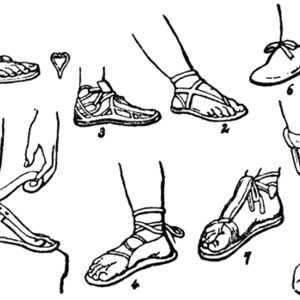 Greek shoes (from the book: Guhl E. K., Koner W. D. Das Leben der Griechen und Römern. B., 1893. Fig. 223): 1 (statue of Elpis in the Vatican), 2 and 3 (statue of Apollo Belvedere) – different types of sandals and their fastenings, from the simplest to the most complex; 4, 5 and 7 (statue of Demosthenes) – different types of shoes that partially cover the foot; 6 – fully closed shoe; 8 – an example of an endromid, or high hunting boots
Greek shoes (from the book: Guhl E. K., Koner W. D. Das Leben der Griechen und Römern. B., 1893. Fig. 223): 1 (statue of Elpis in the Vatican), 2 and 3 (statue of Apollo Belvedere) – different types of sandals and their fastenings, from the simplest to the most complex; 4, 5 and 7 (statue of Demosthenes) – different types of shoes that partially cover the foot; 6 – fully closed shoe; 8 – an example of an endromid, or high hunting boots